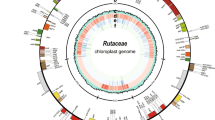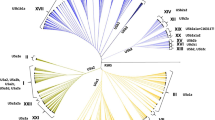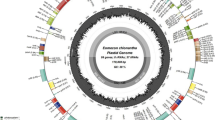Abstract
Evolutionary relationship between disjunct populations of the palaeoaustral moss taxonLopidium concinnum (Hypopterygiaceae) from New Zealand and southern South America were studied using non-coding chloroplast DNA sequences. No or only slight changes could be observed within the sequences oftrnTUGU —trnLUAA 5′exon intergenic spacer,trnLUAA intron andtrnLUAA 3′exon —trnFGAA intergenic spacer. This indicates nearly no genetic divergence between extant New Zealand and Chilean populations, i.e. no significant differing pathways of evolution within the 80–60 million years of disrupted areas with interrupted gene flow. Molecular data support the idea of an old Gondwanan relict species of stenoevolutionary character. Ecological data on short-range dispersal strengthen this assessment.
Similar content being viewed by others
References
Böhle U.-R., Hilger H. H., Cerff R., Martin W. (1994) Noncoding chloroplast DNA for plant molecular systematics at the infrageneric level. In: Schierwater B., Streit G. P., Desalle R. (eds.) Molecular ecology and evolution: approaches and applications. Birkhäuser, Basel, pp. 391–403.
Böhle U.-R., Hilger H. H., Martin W. (1996) Island colonization and evolution of the insular woody habit inEchium L. (Boraginaceae). Proc. Natl. Acad. Sci. USA 93: 11740–11745.
Doyle J. J., Doyle J. L. (1990) Isolation of plant DNA from fresh tissue. Focus 12: 13–15.
Fangan B. M., Stedje B., Stabbetorp O. E., Jensen E. S., Jakobsen K. S. (1994) A general approach for PCR-amplification and sequencing of chloroplast DNA from crude vascular plant and algal tissue. BioTechniques 16: 484–494.
Frey W. (1990) Genoelemente prä-angiospermen Ursprungs bei Bryophyten. Bot. Jahrb. Syst. 111: 433–456.
Frey W., Beever J. E. (1995) Dendroid bryophyte communities of New Zealand. Nova Hedwigia 61: 323–354.
Galloway D. J. (1991) Phytogeography of Southern Hemisphere lichens. In: Nimis P. L., Crovello T. J. (eds.) Quantitative approaches to phytogeography. Kluwer, Dordrecht, pp. 233–262.
Galloway D. J., Jørgensen P. M. (1987) Studies in the lichen familyPannariaceae II. The genusLeioderma NYL. Lichenologist 19: 345–400.
Gielly L., Taberlet P. (1994) The use of chloroplast DNA to resolve plant phylogenies: Noncoding versusrbcL sequences. Molec. Biol. Evol. 11: 769–777.
Gielly L., Taberlet P. (1996a) Chloroplast DNA sequencing to resolve plant phylogenies between closely related taxa. In: Smith T. B., Wayne R. K. (eds.) Molecular genetic approaches in conservation. Oxford University Press, New York, pp. 143–153.
Gielly L., Taberlet P. (1996b) A phylogeny of European gentians inferred from chloroplasttrnL (UAA) intron sequences. Bot. J. Linn. Soc. 120: 57–75.
Ham R. C. H. J. van, 't Hart H., Mes T. H. M., Sandbrink J. M. (1994) Molecular evolution of noncoding regions of the chloroplast genome in theCrassulaceae and related species. Curr. Genet. 25: 558–566.
Hampe E. (1879) Enumeratio muscorum frondosorum Brasiliae centralis, praecipue provinciarum Rio de Janeiro et S. Paulo, adhuc cognitorum. Vidensk. Meddel. Dansk Naturhist. Foren. Kjøbenhavn, Ser. 4, 1: 162.
Kuhsel M. G., Strickland R., Palmer J. D. (1990) An ancient group I intron shared by eubacteria and chloroplasts. Science 250: 1570–1573.
Matteri C. M. (1973) Revision de lasHypopterygiaceae (Musci) Austrosudamericanas. Bol. Soc. Argentina Bot. 15: 229–250.
Mes T. H. M., van Brederode J., 't Hart H. (1996) Origin of the woody MacaronesianSempervivoideae and the phylogenetic position of the East African species ofAeonium. Bot. Acta 109: 477–491.
Miller H. A. (1982) Bryophyte evolution and geography. Biol. J. Linn. Soc. 18: 145–196.
Ohyama K., Fukuzawa H., Kohchi T., Shirai H., Sano T., Umesono K., Shiki Y., Takeuchi M., Chang Z., Aota S., Inokuchi H., Ozeki H. (1986) Chloroplast gene organisation deduced from complete sequence of liverwortMarchantia polymorpha chloroplast DNA. Nature 32: 572–574.
Schuster R. M. (1979) On the persistence and dispersal of transantarcticHepaticae. Canad. J. Bot. 57: 2179–2225.
Schuster R. M. (1982) Generic and familial endemisms in the Hepatic flora of Gondwana land: origins and causes. J. Hattori Bot. Lab. 52: 3–35.
Schuster R. M. (1983) Phytogeography of theBryophyta. In: Schuster R. M. (ed.) New Manual of Bryology 1: 463–626. Hattori Botanical Laboratory, Nichinan.
Schuster R. M. (1988) Ecology, reproductive biology and dispersal ofHepaticae in the tropics. J. Hattori Bot. Lab. 64: 237–269.
Taberlet P., Gielly L., Pautou G., Bouvet J. (1991) Universal primers for amplification of three non-coding regions of chloroplast DNA. Pl. Molec. Biol. 17: 1105–1109.
Thériot I. (1934) Quelques mousses du Chili austral récoltées à freire par Mr. R. Gillet L., en fevrier 1934. Revista Chilena Hist. Nat. 38: 83–85.
White M. E. (1990) The flowering of Gondwana. Princeton University Press, Princeton.
Zanten B. O. van (1978) Experimental studies on transoceanic long-range dispersal of moss spores in the Southern Hemisphere. J. Hattori Bot. Lab. 44: 455–482.
Author information
Authors and Affiliations
Rights and permissions
About this article
Cite this article
Frey, W., Stech, M. & Meissner, K. Chloroplast DNA-relationship in palaeoaustralLopidium concinnum (Hypopterygiaceae, Musci). An example of stenoevolution in mosses Studies in austral temperate rain forest bryophytes 2. Pl Syst Evol 218, 67–75 (1999). https://doi.org/10.1007/BF01087035
Received:
Accepted:
Issue Date:
DOI: https://doi.org/10.1007/BF01087035




